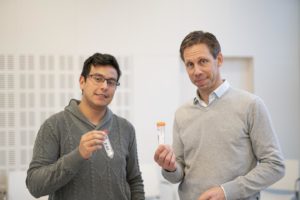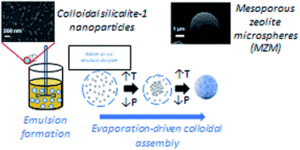We are very pleased to introduce Walter Rosas Arbelaez, first author of the paper ‘Hierarchical micro-/mesoporous zeolite microspheres prepared by colloidal assembly of zeolite nanoparticles‘. His article has been very well received and handpicked by our reviewers and handling editors as one of our October HOT articles. Walter told us more about the work that went into this article and what he hopes to achieve in the future. You can find out more about the author and his article below and find more HOT articles in our online collection.
Meet the authors
Walter Rosas Arbelaez (1987) received his BSc degrees (2011) in Chemistry and Chemical Enginering from Universidad de Los Andes, Colombia. He completed his MSc degrees in Chemical Engineering (2013) at Universidad de Los Andes and in Polymer Science (2016 ) at Martin-Luther University Halle-Wittenberg, Germany. In 2016, he joined Prof. Palmqvist´s research group at Chalmers University of Technology, Sweden to continue his PhD studies in Materials Science focusing on synthesis and characterization of zeolitic materials and mesoporous carbons and the evaluation in different applications. He will be defending his PhD thesis in December 2020.
Could you briefly explain the focus of your article to the non-specialist (in one or two sentences only) and why it is of current interest?
The focus of the article was to develop a zeolite material with two different porosities (micro and meso) using silicalite-1 nanoparticles (ca. 100 nm) and aggregate them by a controlled evaporation process into well-defined micron-sized spheres. In addition, the process does not use any template to form mesopores but only by the interspace generated between the particles after their aggregation. We find this topic of high interest, since many similar materials have been prepared using mesopore templates and/or need long preparation times and high temperature, parameters that have a big impact in the production economics at large scale.
How big an impact could your results potentially have?
As mentioned above, the material prepared in this article does not need a mesoporogen (mesopore template) to generate the mesopores which has a big impact at the production cost. The properties of the materials can be tailored by varying certain synthesis and preparation conditions, offering the possibility to tailor materials based on the desired application. All of these can be prepared by having a method that has few hours of preparation at mild temperatures. Certainly, this will have an impact at the mass-production level .
Could you explain the motivation behind this study?
There are several mesoporous zeolites procedures out there with and without template. However, many of them do not show well interconnectivity of the porosities and have low surface areas, pore volumes and the product does not have a defined morphology and the costs for their production are considerably high.
In your opinion, what are the key design considerations for your study?
First of all, a stable water-in-oil emulsion is crucial, since it is in the water droplets where the assembly of the particles takes place. Further, the nanoparticle size and shape are critical parameters to prepare the material, since nanopartilces with well-defined morphologies are more sutibale for a controlled aggregation. The evaporation conditions such temperature and vacuum also tailor the final properties of the material. Some of this information was learned from a previous work in mesoporous silica microparticles done by our co-authors Andreas Fijneman and Dr Heiner Friedrich.
Which part of the work towards this paper proved to be most challenging?
The preparation of the colloidal zeolite sol was challenging, not from the synthesis perspective but from the post-treatment, since the pH of the colloidal sol seems to have an impact on the formation of the microspheres.
What aspect of your work are you most excited about at the moment?
We feel that our work has shown a new method that cannot be classified among the usual categories to prepare hierarchical zeolites and that through our method we can prepare mesoporous zeolite with well-defined morphology and good pore interconnectivity. Additionly it has one the highest pore volumes and surface areas reported for mesoporous zeolites made of similar zeolite structures. The method also enables the use of different zeolite particles both in size and nature and this can potentially generate multifunctional materials for applications in catalysis and separation. Last but not least, we see that our method is energy and cost efficient and can be implemented at the industrial level.
What is the next step? What work is planned?
The next step is to prepare mesoporous zeolites from different colloidal zeolites such as beta, TS-1 or ZSM-5 and measure their catalytic activity towards different reactive systems. Unfortunately, I will not take part on this, as in December, I will be defending my PhD thesis and in January I will join new projects, but hopefully some other members of my group will follow up.
Hierarchical micro-/mesoporous zeolite microspheres prepared by colloidal assembly of zeolite nanoparticles
Walter Rosas-Arbelaez, Andreas J. Fijneman, Heiner Friedrich and Anders E. C. Palmqvist
RSC Adv., 2020,10, 36459-36466
DOI: 10.1039/D0RA07394F, Paper
 Submit to RSC Advances today! Check out our author guidelines for information on our article types or find out more about the advantages of publishing in a Royal Society of Chemistry journal.
Submit to RSC Advances today! Check out our author guidelines for information on our article types or find out more about the advantages of publishing in a Royal Society of Chemistry journal.
Keep up to date with our latest HOT articles, Reviews, Collections & more by following us on Twitter. You can also keep informed by signing up to our E-Alerts.












